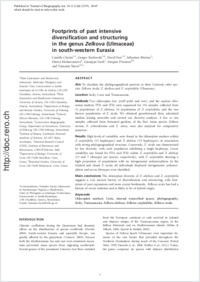Footprints of past intensive diversification and structuring in the genus Zelkova (Ulmaceae) in south-western Eurasia
- Christe, Camille Plant Systematics and Biodiversity Laboratory, Molecular Phylogeny and Genetics Unit, Conservatoire et Jardin botaniques de la Ville de Genève, Geneva, Switzerland - Department of Biology and Botanic Garden, University of Fribourg, Fribourg, Switzerland
- Kozlowski, Gregor Department of Biology and Botanic Garden, University of Fribourg, Fribourg, Switzerland - Natural History Museum, Fribourg, Switzerland
- Frey, David Department of Biology and Botanic Garden, University of Fribourg, Fribourg, Switzerland - Conservation Biogeography Group, Department of Geosciences, University of Fribourg, Switzerland
- Bétrisey, Sébastien Department of Biology and Botanic Garden, University of Fribourg, Fribourg, Switzerland
- Maharramova, Elmira Institute of Botany, Azerbaijan National Academy of Sciences, Baku, Azerbaijan
- Garfì, Giuseppe National Research Council CNR , Institute of Biosciences and Bioresources, Palermo, Italy
- Pirintsos, Stergios Department of Biology, University of Crete, Greece - Botanical Garden, University of Crete, Crete, Greece
- Naciri, Yamama Plant Systematics and Biodiversity Laboratory, Molecular Phylogeny and Genetics Unit, Conservatoire et Jardin botaniques de la Ville de Genève, Geneva, Switzerland - Plant Systematics and Biodiversity Laboratory, University of Geneva, Geneva, Switzerland
-
01.01.2014
Published in:
- Journal of Biogeography. - 2014, vol. 41, no. 6, p. 1081-1093
Chloroplast markers
Crete
internal transcribed spacer
phylogeography
Sicily
Transcaucasia
Zelkova abelicea
Zelkova carpinifolia
Zelkova sicula
English
Aim: To elucidate the phylogeographical patterns in three Cenozoic relict species: Zelkova sicula, Z. abelicea and Z. carpinifolia (Ulmaceae).Location: Sicily, Crete and Transcaucasia.Methods: Two chloroplast loci (trnH–psbA and trnL) and the nuclear ribosomal markers ITS1 and ITS2 were sequenced for 154 samples collected from 14 populations of Z. abelicea, 16 populations of Z. carpinifolia, and the two known populations of Z. sicula. We obtained georeferenced data, calculated median joining networks and carried out diversity analyses. A few ex situ samples collected from botanical gardens, of the East Asian species Zelkova serrata, Z. schneideriana and Z. sinica, were also analysed for comparative purposes.Results: High levels of variability were found in the chloroplast markers within Z. carpinifolia (15 haplotypes) and Z. abelicea (33 haplotypes), in association with strong phylogeographical structure. Conversely, Z. sicula was characterized by low diversity, with each population exhibiting a single haplotype. Lower variability was found for ITS1 and ITS2 within Z. carpinifolia and Z. abelicea (13 and 7 ribotypes per species, respectively), with Z. carpinifolia showing a high proportion of populations with no intragenomic polymorphism. In the triploid and clonal Z. sicula, all individuals displayed intragenomic polymorphism and seven ribotypes were identified.Main conclusions: The chloroplast diversity of Z. abelicea and Z. carpinifolia suggests a very ancient history of diversification and structuring, with footprints of past expansions and more recent bottlenecks. Zelkova sicula has had a history of severe isolation and is likely to be of hybrid origin.
- Faculty
- Faculté des sciences et de médecine
- Department
- Département de Biologie
- Language
-
- English
- Classification
- Biological sciences
- License
-
License undefined
- Identifiers
-
- RERO DOC 209898
- DOI 10.1111/jbi.12276
- Persistent URL
- https://folia.unifr.ch/unifr/documents/303579
Other files
Statistics
Document views: 165
File downloads:
- pdf: 426
- Supplementary material: 165

